Thyssenkrupp: Building up effective IP coverage efficiently within an international engineering conglomerate
A lecture by Dr. Stephan Wolke, CEO thyssenkrupp Intellectual Property GmbH, on how the task of IP in the Thyssenkrupp Group ensures the ability to act in a business in a global context.
Abstract
The task of IP in the thyssenkrupp Group is to ensure the ability to act in our business in a global context.
This requires the following elements (Figure 1)

- To create an effective patent protection for the group
- Creating a patent protection screen at a global level
- Stimulate and incentivize technical ideas
- Creating an IP focus for these ideas
- Understanding the competitive IP environment
- To develop this patent protection in an efficient manner
- Ensuring that the business decides on the extent of its own IP protection
- Building an IP community and creating attention for IP in the group
- Strategic management of brands as part of IP
- Adjustment of the right proportion of external and internal resources
Introduction/Initial Position
thyssenkrupp is a global engineering group with more than 40 billion Euro in sales and more than 150,000 employees, operating in five business areas (automotive components, elevators and escalators, plant construction and shipbuilding, material services as well as steel) with a strong business presence in Europe.
In comparison with the regions of the world, Europe is right behind China with the second strongest growth in IP at approx. 3% per year
Due to the establishment of a patent department inside the group, the key dimensions „effective patent protection“ as well as „efficient build-up of patent protection“ have significantly improved for thyssenkrupp in recent years.
Creating an effective patent protection for the group
Implementation of a patent protection screen at a European and a global level
By the implementation of a patent protection screen, one should pursue two objectives (Figure 2):
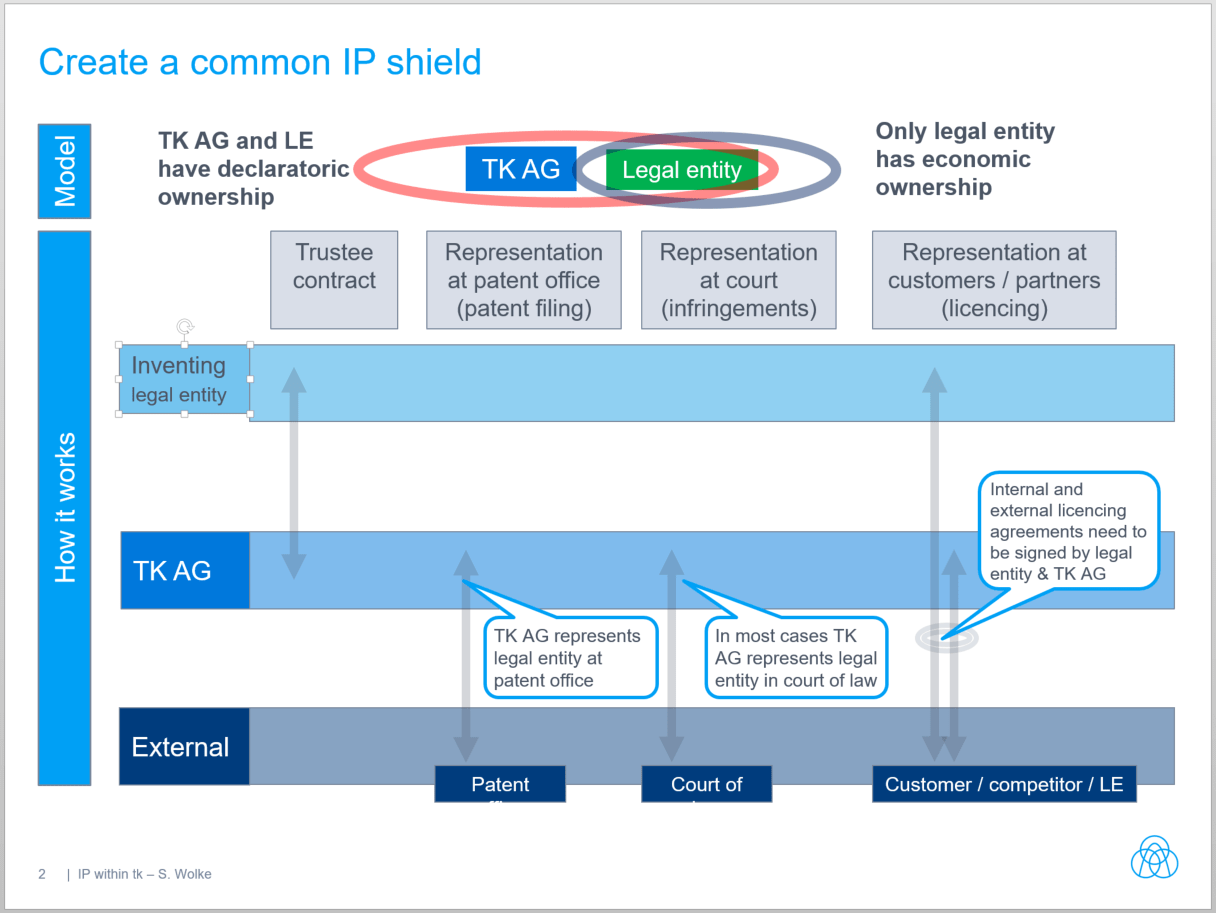
- on the one hand, the visibility of the patent portfolio of the group under one name (thyssenkrupp AG) as well as ensuring the ability to act against patent offices and courts
- on the other hand avoidance of tax risks by shifting the economic propertyship of patents between business units of the group.
Both of these objectives are taken into account by the chosen solution, hence we decide between
- economic propertyship of the patent, which is being held by the business unit
- declaratory propertyship of the patent, which is shared by the notifying business unit as well as the thyssenkrupp AG.
This construction has now been established in all relevant countries for newly emerging patents for three years.
Stimulate and incentivize technical ideas
In order to stimulate technical ideas, thyssenkrupp has made use of a large variety of formats, such as the TRIZ methodology and others. Thus, in a workshop with approx. 10 developers/engineers as well as one of our patent attorneys (Figure 3)
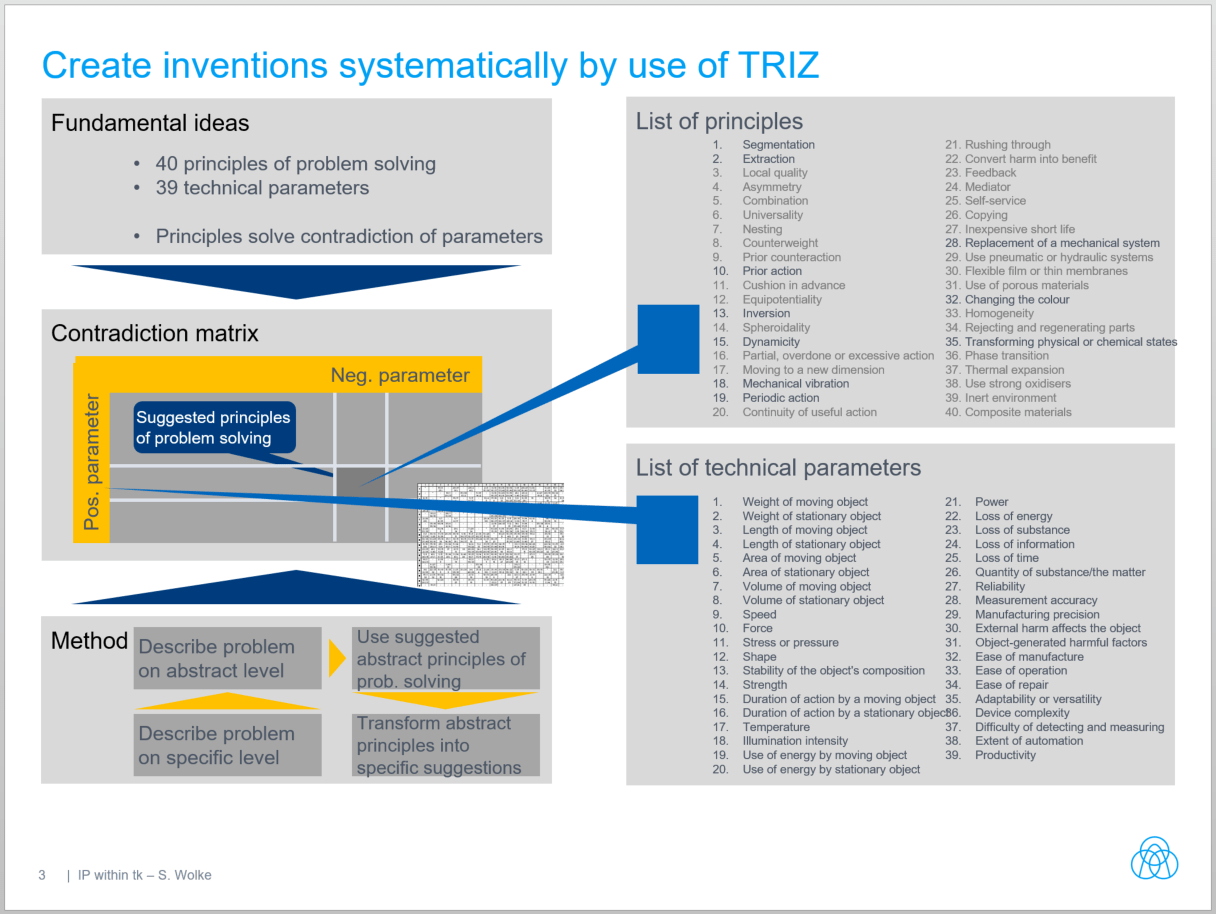
- a technical problem will be abstracted
- an abstract will be solved by means of transition matrices within the TRIZ methodology
- will be transferred back to the original problem situation
Although the problem can usually not be fully solved, in the course of such a day between 20 and 50 technical ideas or subsequent invention disclosures can be generated.
We modified this methodology and make use of it for inventions in the area of spare parts/service as well as inventions in the area of software/hardware combinations.
Furthermore, trainings are held for all relevant target audiences within the group (inventors, general public, management, …)
Additionally, a uniform flat-rate remuneration system is currently implemented throughout the world.
Determination of an IP focus of these ideas
To achieve a focus on the technical ideas, a complete and clear presentation of the used technologies (the so-called technology tree) was developed together with all business units (Figure 4).

Subsequently,
- the own property rights were assigned to the individual branches of the tree
- third-party intellectual property rights were determined for the individual branches of the tree
- this results in an „IP gap“, i.e. areas in which the group company has less IP than its competitors
- additionally, the group companies often defined their own technology focus areas from the R&D strategy
From these two sources, „IP gap“ and technology focus area, the IP focus for the group company is being defined.
The effectiveness of IP protection (revision of the IP focus as well as the degree of patent coverage of the present and future product base) and the IP efficiency (revision of the current portfolio, development of license strategy, derivation of the initial application claim from the competition) will be discussed in an annual IP Dialog (Figure 5).
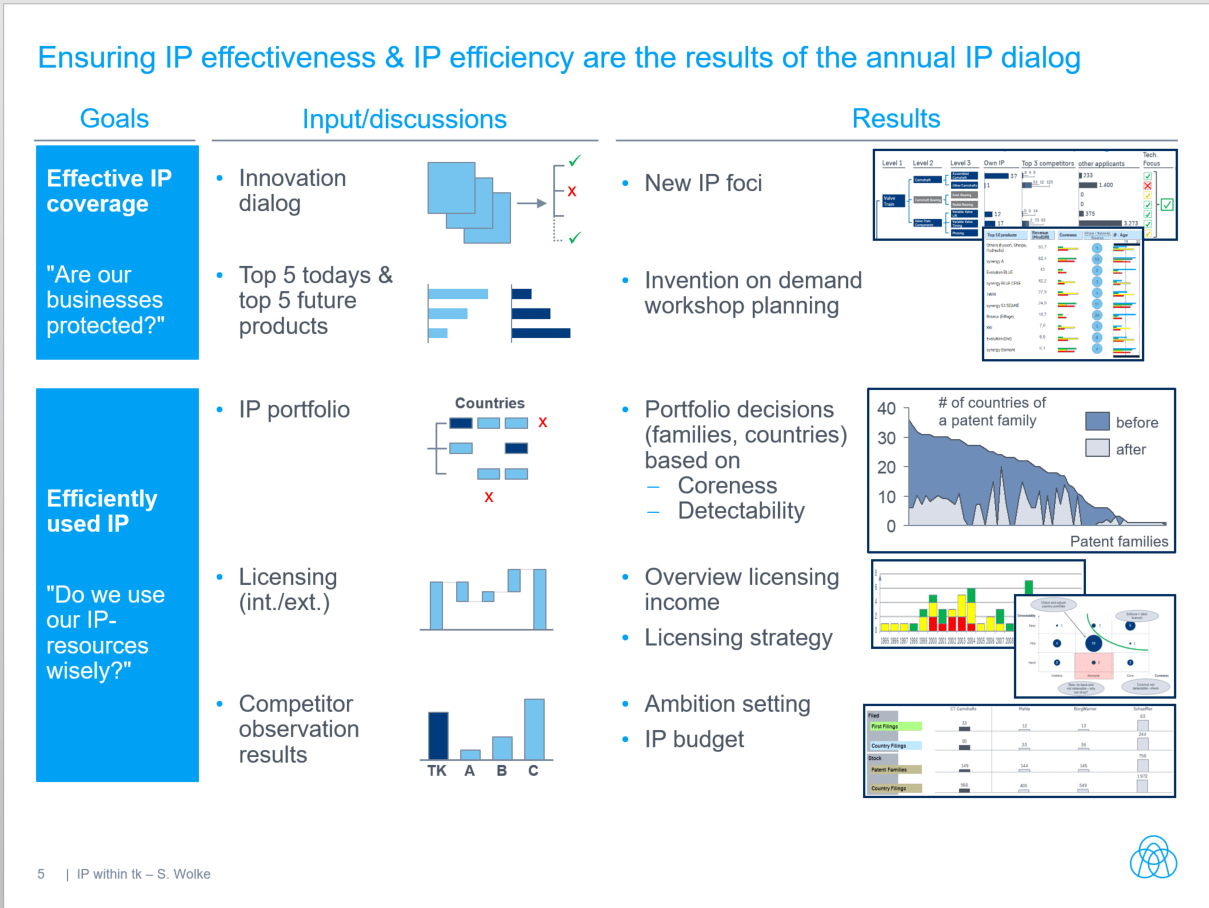
Understanding of the competitive IP environment
In order to understand the competitive situation for IP, an IP competition monitoring system was installed on the basis of the above-mentioned technology trees, in which more than 600 users view and evaluate the results on a monthly basis (Figure 6) .
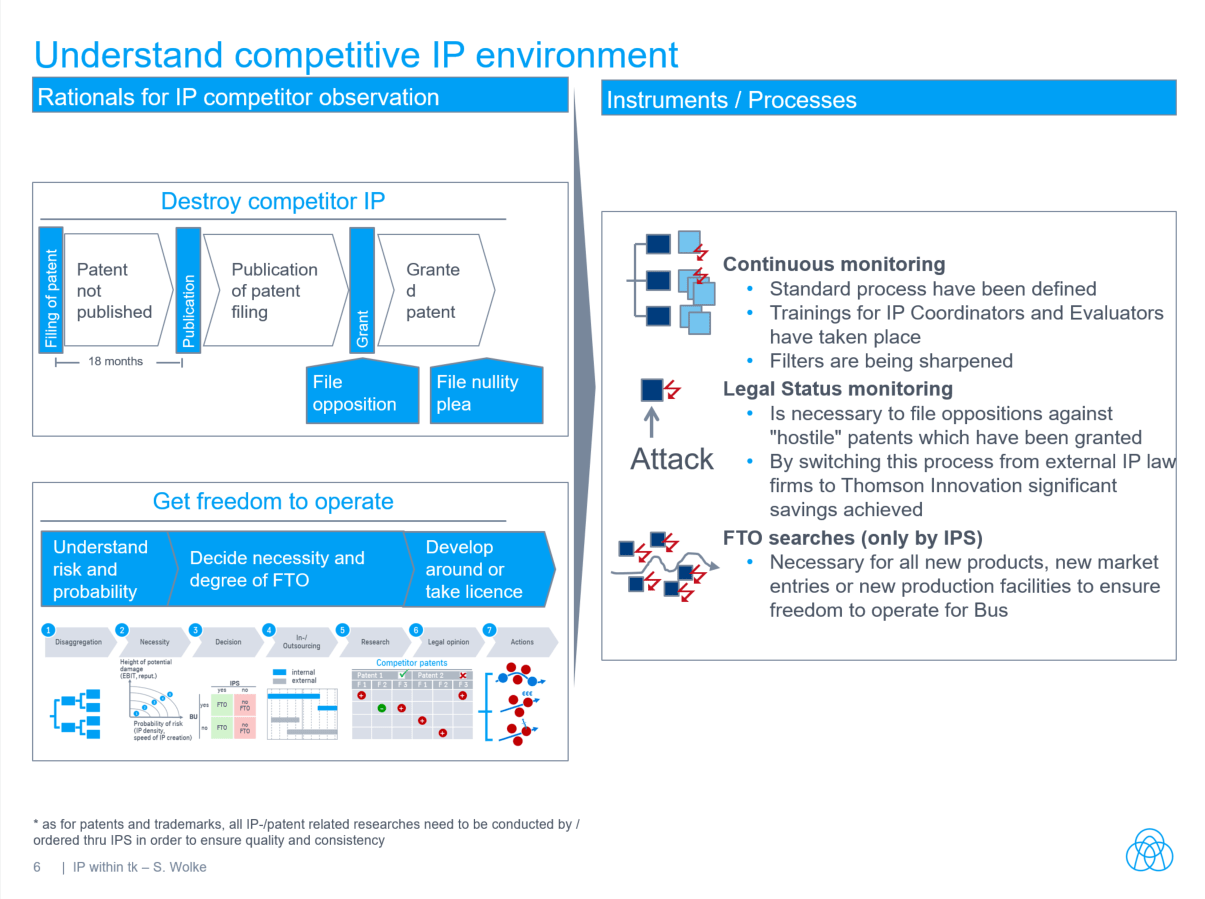
The necessity for FTO searches will be assessed together with the business units on the basis of the magnitude of damage and the probability of damage occurrence in a systematic FTO process. Subsequently, it will be carried out in varying degrees with external and internal resources.
The assessment of proprietary and non-proprietary rights (Figure 7)
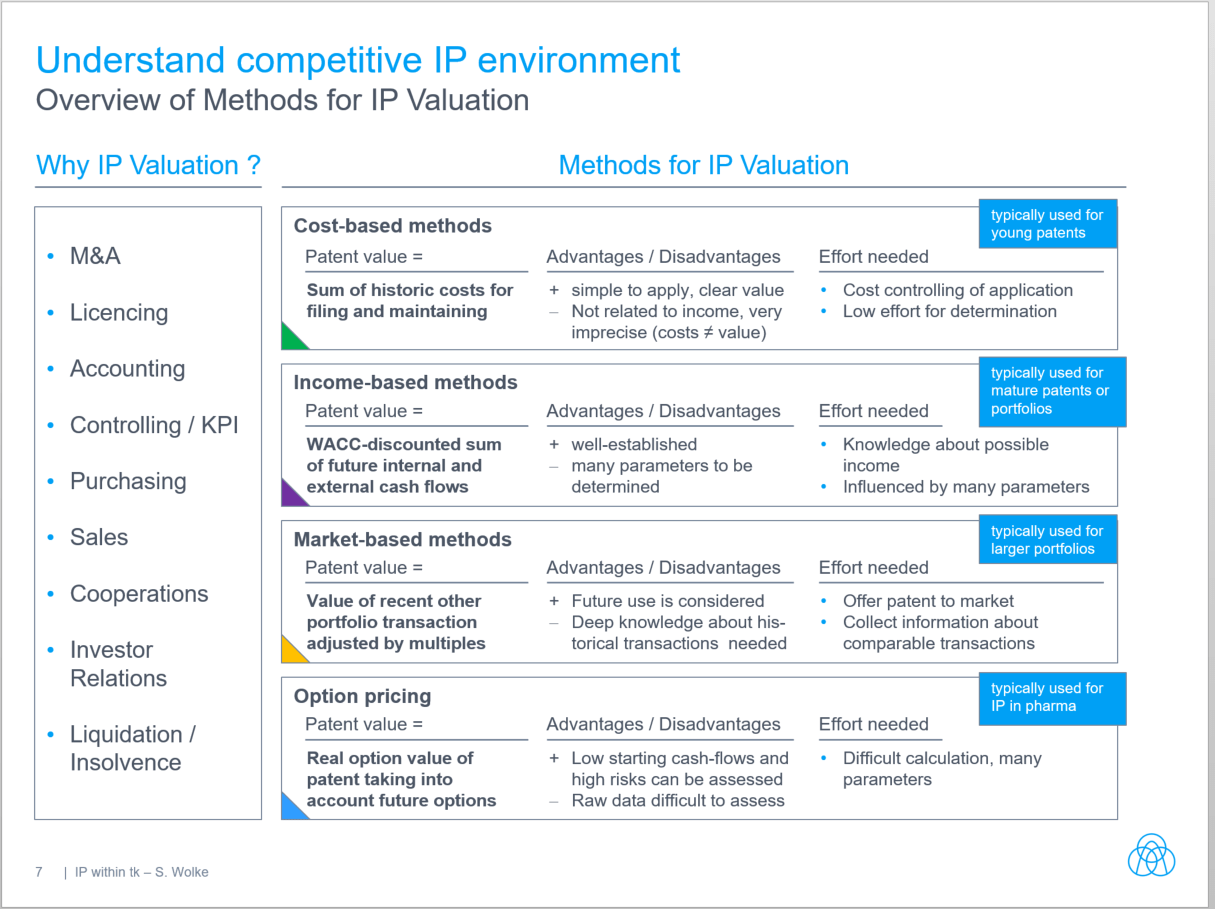
is carried out
- for young patents based on the costs of their creation
- for older patents based on the discounted cash flow, which is generated by their existence
- for larger portfolios based on transactional levels of similar portfolios, attested by multiples
- in exceptional cases also with option pricing based on the Black-Scholes-formulas
To build up a licensing business,
- interesting markets and companies will be identified
- indicators for patent infringements will be developed
- the own and third-party portfolios will be analyzed for conformity with respect to technology, countries, age and discoverability
Methods for detecting patent infringements have been developed and include, inter alia,
- together with the business unit.
- analysis of public material
- structured and prepared visits to fairs
- reverse engineering
- aptitude for the service staff to maintain external systems
- public crowd searching
Development of this patent protection in an efficient way
Ensuring that the business decides on the scope of its own IP protection
Basically, the patents and trademarks economically belong to the business units and the units are responsible for the scope of protection. Not only comprises this responsibility the costs of creation and maintenance of the IP, but also the incurring license revenues if applicable. In order to fulfill this responsibility, all the group’s business units have established a so-called Operative Patent Council (OPC), (Figure 8) in which
- Head of R&D
- Head of M&S
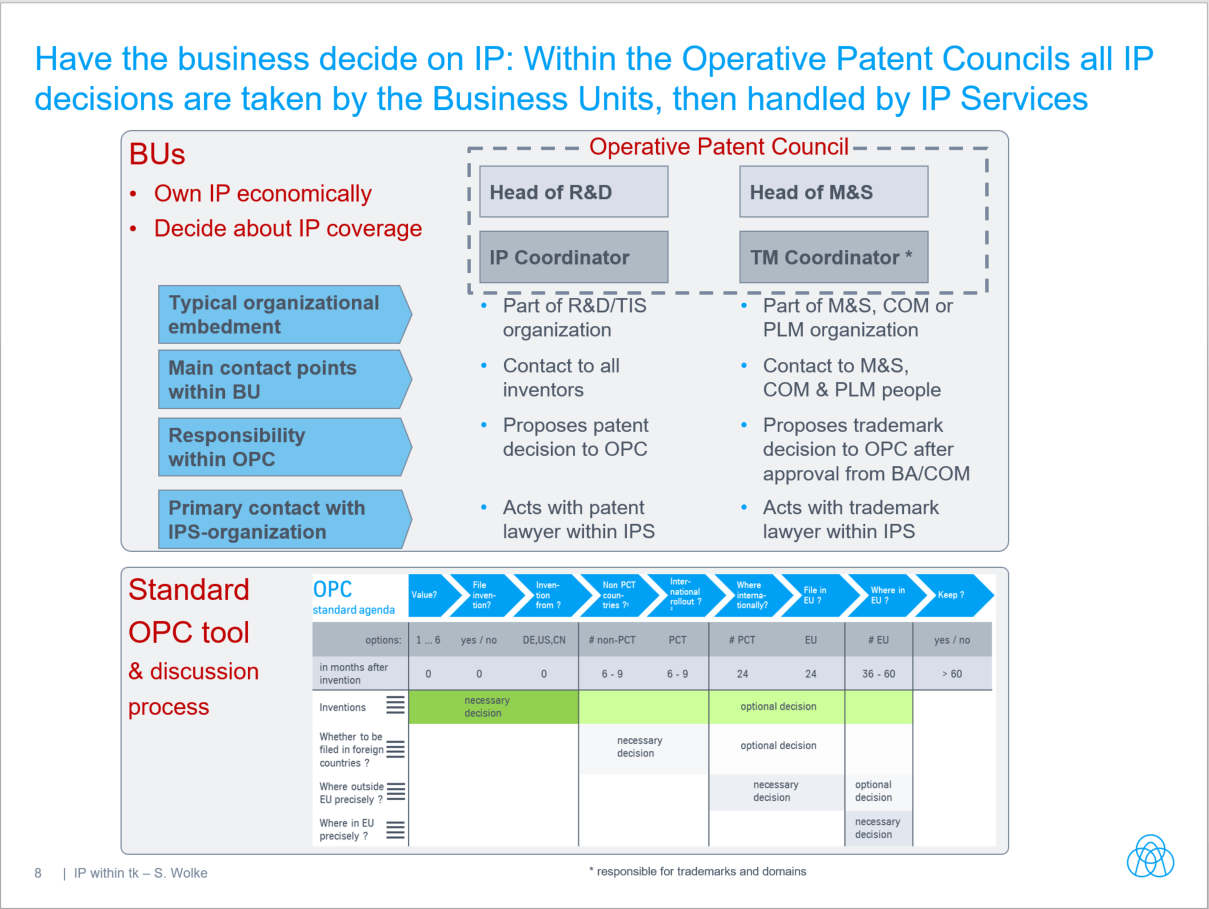
jointly define the scope of the patent protection. This quarterly session takes place for about 2 hours and will be prepared by
- the IP coordinator of the business unit, who keeps in touch with all inventors and makes a suggestion in the OPC which inventions should be filed as a patent application in which countries.
- the TM(trademark) coordinator of the business unit, who keeps up with marketing, sales, product management, as well as communication and makes a suggestion which trademarks are needed or should be extended.
Additionally, it was stipulated for all group companies in the catalog of transactions requiring approval that the following procedures require approval and implementation of the IP department:
- creation of IP (patents, trademarks)
- disposal of IP (sale, licensing)
- legal disputes in the context of IP
- change of the model clauses to IP in contracts with all external parties
Building an IP community and creating attention for IP in the Group
To create attention and enthusiasm for IP in the group as well as to ensure the utility of the implemented processes, the above-mentioned IP coordinators and TM coordinators will be annually and centrally invited several times a year.
To ensure that the group constitutively copes with all aspects of IP in contracts with external parties (employees, suppliers, cooperation partners, academic partners as well as customers) in an interest proportionate manner, the project „IP in every contract“ was launched and is currently implemented with all the relevant group functions (Figure 9).

Key figures measure the achievement of the strategic IP goals (Figure 10) and are usually formed in the process chain of the IP generation as the quotient of the individual steps.
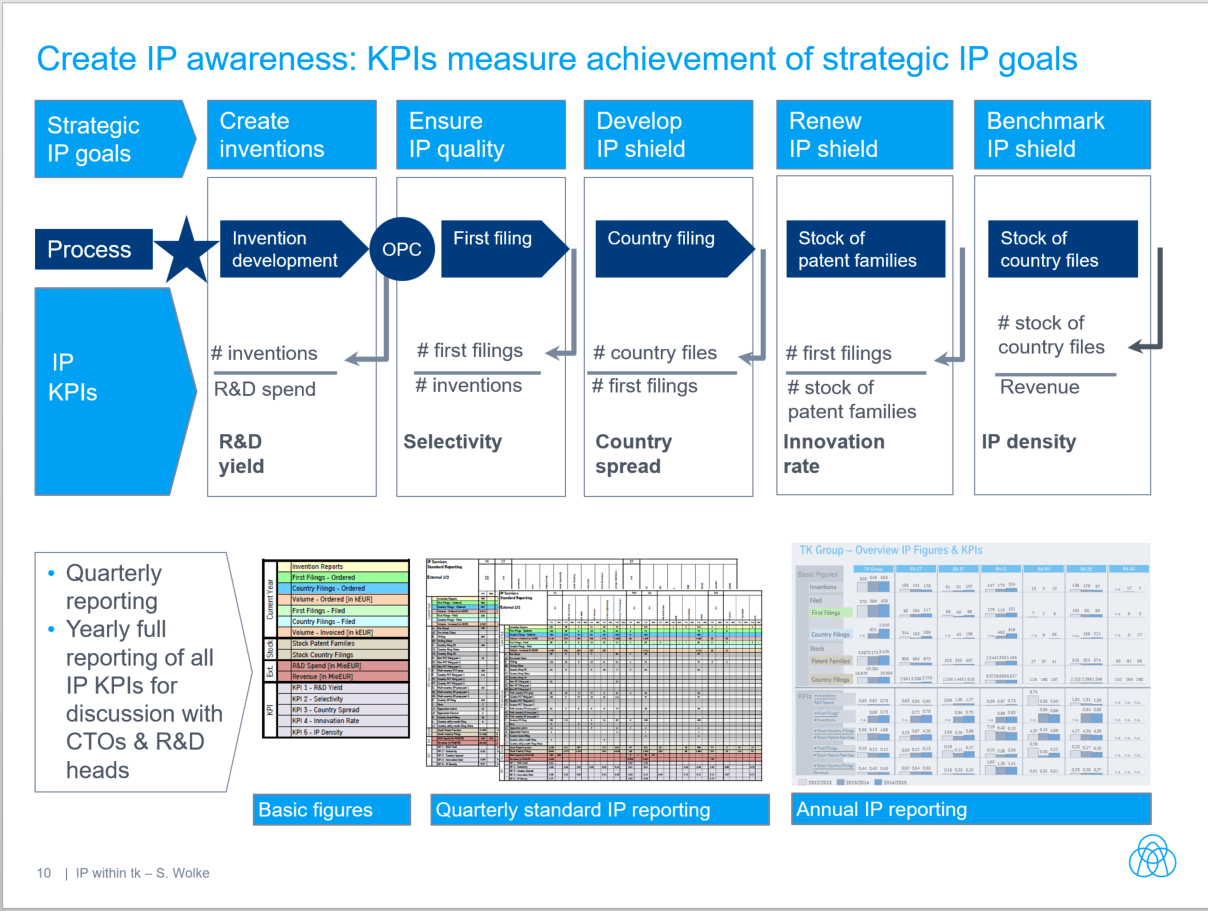
Strategic management of brands as part of IP
Due to the responsibility of the IP department for the group’s trademark
- the trademark processes were redefined (early involvement of the IP department in naming, registration, design of contracts / if applicable, license agreements for internal or external use, proof of use for own use in all countries and product classes, …
- the new corporate trademark was registered with its own resources in all relevant countries of the world as well as in up to 18 product classes.
- Strategies were developed to defend the trademarks which are no longer in use to the same extent as before, such as Krupp, HDW, Uhde, …
Adjustment of the right proportion of external and internal resources
To ensure the decision-making ability of the OPCs (which should make their decisions on IP services based on full costs), service packages have been defined which group-internal transfer prices will be annually adjusted due to increasing insourcing.
The existing portfolio of the law firm has been reduced due to insourcing, whereby the services will be purchased on the basis of standardized service providers. The management of law firms is supported by annually qualitative and quantitative reviews.
The IP staff of the group (patent attorneys, brand attorneys, paralegals) was bundled in the thyssenkrupp Intellectual Property GmbH.
This is currently structured according to
- teams of patent attorneys who are each responsible for a business area
- a trademark team
- two field locations in our regional headquarters in Beijing and Chicago with about 4 employees each
- one sector patent law clerks
- one department IP strategy / research
- as well as the department management of law firms / IP operations
The internal and external communication was started by making use of
- the intensification of the presence in Intranet, newsletters, …
- the participation in industrial associations (economic association steel, VDMA, VDA, BDI, …), in each case in the committees for the protection of industrial property
- presentations at international patent congresses
Through all these measures, a development for the construction of an effective IP protection screen has been launched in an efficient manner, but there are still a few more steps to go until reaching the achievement of vision 2020 (Figure 11).




